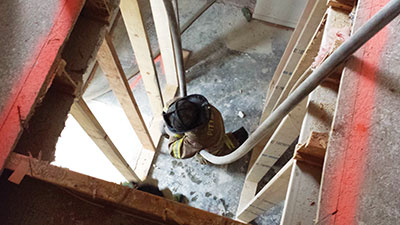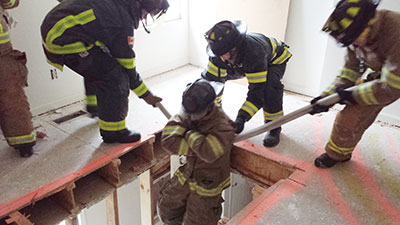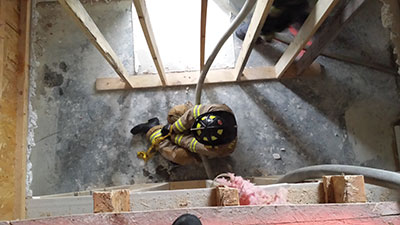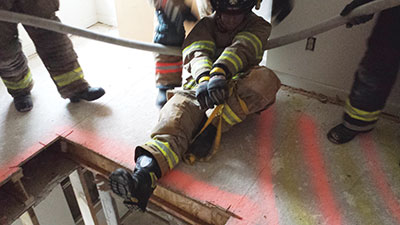
Features
Structural
Training
Back to Basics: July 2014
When rescuing a firefighter who has fallen through a fire-weakened floor to a basement or sub-level of a building, remember to stabilize the area around the hole in the floor.
July 3, 2014
By Mark van der Feyst
When rescuing a firefighter who has fallen through a fire-weakened floor to a basement or sub-level of a building, remember to stabilize the area around the hole in the floor. Interior doors can be quickly and easily removed from their hinges and used as stabilizing platforms.
Also, remember to appoint an operational commander within the structure to oversee the rescue and liaise with the incident commander. The operational command person can also act as the safety officer to ensure that other firefighters and rescuers do not fall into the same hole.
As mentioned in April, the two main tools that can be used for rescue are rope and a charged hoseline. Ground ladders can also be used but are not always practical in sub-level rescues: sometimes ladders are not readily available or there is not enough room for a ladder to be brought in and positioned down into the hole. Also, the injured firefighter would be required to climb up the ladder, meaning he or she would have to be conscious and able-bodied.
We will discuss the use of ropes in sub-level rescues in October. Here, we’ll explain how to use a charged hoseline, which is usually readily available in sub-level rescue conditions.
 |
|
| Photo 1: A charged hoseline is an ideal tool for rescuing a firefighter who has fallen through the floor. Once the hoseline has been lowered far enough, a conscious firefighter can grab it, position himself so that his chest is across the hose, then use his arms to clamp the hoseline tightly to his body. Photos by Mark van der Feyst |
|
 |
|
| Photo 2: There should be at least one firefighter on each side raising the hose and the firefighter; depending on the weight and size of the firefighter being rescued, two firefighters per side may be required. |
To rescue a conscious firefighter, lower a section of the charged line down through the hole so that it forms a horseshoe shape. Once the hoseline has been lowered far enough, the firefighter can grab it and position himself so that his chest is across the hose; he then uses his arms to clamp the hoseline tightly to his body (see photo 1). At this point, members of the rapid-intervention team (RIT) pull the firefighter to safety.
In this type of rescue, there should be at least one firefighter on each side (see photo 2) raising the hose; depending on the weight and size of the firefighter being rescued, two firefighters per side may be required.
All firefighters involved in the rescue must use a dynamic power lift, which means an intense amount of energy is exerted in a very short time.
Once the RIT members get the firefighter up to the top of the hole, another firefighter can grab him and pull him to safety. Remember that there will be an SCBA to contend with; this can impact the rescue if any parts get caught on the edge of the hole.
When the firefighter’s waist is level with the hole, rescuers must make sure he will not fall back down. Position the firefighter so that he can bend at the waist when he is pulled out of the hole. This makes the job a little bit easier as the body will naturally bend in a certain direction and will not create further discomfort or harm. Still, there is a good chance that the firefighter will fall back into the hole because of his center of gravity and the weight of the SCBA on his back. If the firefighter starts to fall backwards, little can be done to prevent him from doing so. To prevent the firefighter from falling backwards, firefighters should pull him out of the hole with their backs toward the landing area (which creates an unnatural bend of the body); this
ensures that the firefighter will not fall back in but rather have the weight distribution pull him towards the safer area.
 |
|
| Photo 3: When the rescue preparations are completed, the hoseline should be between the firefighter’s arms and his leg and ready for hoisting.
|
|
 |
|
| Photo 4: To rescue an unconscious firefighter, the RIT firefighters pull up the hose, with the unconscious firefighter secured by his arms and one leg.
|
What if the trapped firefighter is unconscious? Can the charged the hoseline be used as a rescue tool? Absolutely. A RIT member can be sent down to the sub-level using the hoseline like a pole slide. The RIT firefighter grabs onto the hose with his hands above the hole in the floor while lowering his body into the hole, wrapping his legs around the hose and then walking his hands down the hose until he is below the floor surface. At this point, the RIT firefighter can slide the rest of the way down.
Once the RIT member reaches the unconscious fallen firefighter, he can start to package the firefighter for removal using a piece of webbing and the charged hoseline. The RIT firefighter ties a handcuff knot with the webbing so that the two loops will fit over the arms of the fallen firefighter. The two loops will be cinched tightly around the firefighter’s arms, with the arms over the hoseline. The other end of the webbing is then tied around one of the firefighter’s legs – either leg, with any kind of knot. No special knot is required, just something to prevent the webbing from coming undone.
When the rescue preparations are completed, the hoseline should be between the firefighter’s arms and his leg and ready for hoisting (see photo 3). The RIT firefighters then pull up the hose, with the unconscious firefighter secured by his arms and one leg (see photo 4). Once the unconscious firefighter has been pulled up through the hole to waist height, he can be pulled backward out of the hole to safety.
These hoseline rescue techniques work well only when they are practised ahead of time; doing so is simple and requires only a charged hoseline, a piece of webbing and a hole in the floor.
In October, we will discuss the use of ropes for conducting the same type of rescue.
Mark van der Feyst is a 15-year veteran of the fire service and currently works for the City of Woodstock Fire Department. Mark is an instructor teaching in Canada, the United States, at FDIC and in India. He is a local-level suppression instructor for the Pennsylvania State Fire Academy and an instructor for the Justice Institute of BC. Contact him at Mark@Firestar-Services.com
Print this page